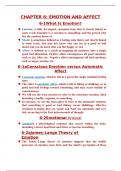CHAPTER 6: EMOTION AND AFFECT
6-1What Is Emotion?
Emotion: a fully developed, conscious state that is clearly linked to
some event. Emotion is a reaction to something, and the person who
has the emotion knows it.
Mood: is sometimes defined as a feeling state that is not clearly linked
to some event. You may not know why you are in a good or bad
mood, but you do know that you feel happy or sad.
Affect: is defined as a result of mapping all emotions onto a single
good–bad dimension. Positive affect encompasses all good emotions,
such as joy, bliss, etc. Negative affect encompasses all bad emotions,
such as anger, anxiety, etc.
6-1aConscious Emotion versus Automatic
Affect
Conscious emotion, which is felt as a powerful, single (unified) feeling
state.
The other is automatic affect, which is felt as liking or disliking, or as
good and bad feelings toward something, and may occur outside of
consciousness.
We will use the term emotion to refer to the conscious reaction, often
including a bodily response, to something.
In contrast, we use the term affect to refer to the automatic response
that something is good or bad (liking versus disliking). Affective
reactions to things that are ‘good’ and ‘bad’ are automatic and very
fast, occurring in the first microseconds of thought.
6-2Emotional Arousal
Arousal is a physiological response that occurs within the body,
including a faster heartbeat and faster or heavier breathing.
6-2aJames–Lange Theory of
Emotion
The James–Lange theory of emotion suggests that the bodily
processes of emotion come first, and the mind’s perception of these
, bodily reactions then creates the subjective feeling of emotion.
One important aspect of the theory is that different emotions must
arise from different bodily responses. However, data from many
studies suggested that the body’s response seemed to be very similar
for different emotions.
Studies found that bodily responses seemed quite similar for various
emotions.
Tears, for example, aren't exclusive to sadness; people cry when
happy, angry, or afraid. Tears are more a sign of intense feeling than
a specific emotion.
Facial Feedback Hypothesis:
Suggests that facial expressions can trigger or amplify emotions
because the brain responds to facial muscle movements.
Studies supported this idea.
An example: Holding a pen between your teeth makes your
face look like a smile, and you find things funnier. Holding it
between your lips makes your face frown.
Impact on Emotional Recognition:
Botox injections reduce facial feedback by paralyzing facial
muscles to reduce wrinkles.
This unintentionally affects emotional recognition.
People who had Botox were less accurate at recognizing
emotions in others.
Facial feedback helps us understand other people's emotions; if
your face can't react, it impairs your ability to read emotions.
6-2bSchachter–Singer Theory of Emotion
Instead of claiming that feeling emotion is a direct result of the bodily
reaction, Schachter and Singer said that emotion has two separate
components – physiological arousal and cognitive label.
Physiological Arousal:
This is the physical response that happens when the
sympathetic nervous system is activated.
It includes a faster heart rate, increased blood flow to muscles
and the brain, and other changes.
, Nervousness, like before a big test or performance, is an
example of arousal on its own. It's the physical part of an
emotion without a specific label.
So, Schachter and Singer's theory suggests that emotions involve
both a common physical arousal component and a unique cognitive
label component that varies depending on the specific emotion.
In the Schachter–Singer theory of emotion, emotion is something like
a television programme. The arousal is the on/off switch and volume
control: it determines that there is going to be an emotion, and how
strong it will be. The cognitive label is like the channel switch: it
determines what emotion will be felt.
6-2cMisattribution of Arousal
One interesting aspect of the Schachter–Singer theory is that it allows
for arousal states to be mislabelled or re-labelled. That is, arousal
may arise for one reason but get another label, thereby producing a
different reaction.
Example - Excitation Transfer (the idea that arousal from one event
can transfer to a later event):
Imagine someone unknowingly drinks a caffeinated beverage
(e.g., regular coffee) and experiences arousal.
Later, something frustrating happens, and the extra,
unexplained arousal from the caffeine gets "transferred" to
this situation.
As a result, the person might become much angrier than they
would have been otherwise.
More recent studies indicate there are likely at least two basic arousal
states: one pleasant and one unpleasant.
Neutral states induced chemically (e.g., caffeine, exercise, or explicit
movies) can be converted into various emotions, both positive and
negative.
Arousal that arises naturally due to real-life experiences tends to be
either pleasant (good) or unpleasant (bad).
"Good" arousal can't easily be converted into "bad" arousal, and
vice versa.
Conscious Emotion and Automatic Affect:
Conscious emotions take time to develop.
Automatic affect, which occurs quickly, influences the
emerging conscious emotion.




